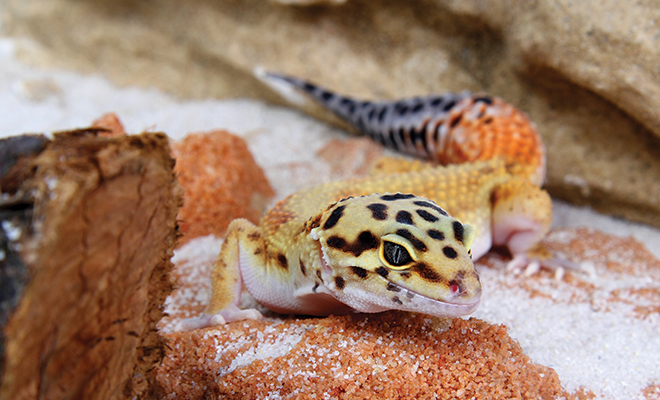
Scaly Babies: Pets With Surprising Personality
Pets are nurturing, affectionate and entertaining. They are trainable, funny and great snugglers.
The reasons people should own pets are numerous. For adults, they can provide companionship and protection. For kids, four-legged friends can teach responsibility and unconditional love.
A national survey of pet owners conducted by the American Pet Products Association in 2017 revealed that 68 percent of U.S. households, or about 85 million families, own a pet. Dogs topped the list of most popular pets at 60 percent, and cats, at 47 percent, ran a close second. Further down the list, right above horses and saltwater fish, is another pet group that’s overlooked but is still loads of fun: reptiles.
Before you shudder at the thought, consider that many reptiles are easy to care for and are even used as therapy animals in homes and schools. Geckos and Bearded Dragons have very mellow dispositions that have proven to be effective calming tools for children on the autism spectrum or very anxious kids.
Care and Feeding of Your Reptile
Owning a pet of any kind is a huge commitment, and having a reptile is no different. Although most lizards and snakes are easy to care for, they still require an investment of time and resources to make sure they have a healthy and happy forever home. For reptiles, this means a proper habitat and feeding plan, and even reptiles have to see the veterinarian once in a while.
If you’re ready to bring a new cold-blooded creature home to love, the question remains. Which reptiles are known to have good temperaments and be great for beginners?
Leopard Geckos
Because “leos” start off small and remain that way, they are one of easiest lizards to care for. These nocturnal critters require a 15- to 20-gallon tank for a home and need a heat lamp and a UV light to help them stay happy and healthy. They eat live insects and they’re especially fond of crickets and mealworm, both of which can be bought at a pet store or online. Because of their docile nature, they are easy to handle, making a leo a no-brainer when it comes to choosing a beginner lizard.
Bearded Dragons
While “beardies” need a little more complex care and tend to get bigger than a gecko, they are very social and loved to be held and talked to. They require UVB lighting and their tank size should be no less than 20 gallons, preferably up to 70 gallons.
Bearded dragons are omnivores, meaning they eat both plants and animals. When bearded dragons are very young, they generally eat 80 percent bugs and 20 percent plants, but adult bearded dragons are nearly the opposite; their diet will consist of 80 percent plants and 20 percent bugs and insects.
Getting Brave with Snakes
Contrary to popular belief, snakes are not slimy and do indeed have personalities. Not all snakes are a wise choice for beginner reptile owners, but these two are an excellent choice.
Corn Snakes
Corn snakes are one of the most friendly and easy to care for among slithering pets. They will grow to be three to five feet long and can live for about ten years. Their tank, a minimum of 20 gallons, must be consistently heated to a temperature of 70 to 85 degrees.
New corn snake owners need to be mindful of their pet’s “Houdini” ways. These sneaky snakes are fairly savvy at escaping, so their owners will need to make sure their tank has a tight-fitting lid. Their diet consists entirely of whole mice that come in a variety of sizes from pinkies and fuzzies, the smallest, to adult mice; all can be purchased frozen from pet stores or online.
Ball Pythons
Although they’re considered a constrictor, ball pythons, or Python regius, are very shy and have sweet dispositions. They grow to three to five feet in length but are thicker than a corn snake. Juveniles need a 10- to 20-gallon tank that is kept around 80 degrees F with a basking spot that’s about 90 degrees. Adult ball pythons will need a 40-gallon or larger tank.
Though they’re sometimes picky eaters, they enjoy the same diet as their corn snake relatives and can be slightly less sneaky about trying to escape. Ball pythons can live to be 20 to 30 years old, so ownership of one isn’t something to take lightly.
Each of these makes a great first-time reptile, but they require attention and care to maintain proper habitat and feeding routines. Future reptile owners need to spend time reading and researching habitat needs and feeding patterns to keep their scaly babies alive and well. But with a little work and love, any one of these reptiles would be the perfect choice as beginner reptile in your life. ■
Sources drsfostersmith.com, iii.org, Petco.com and the experience of the author.







